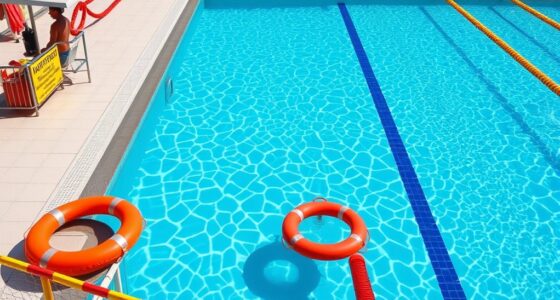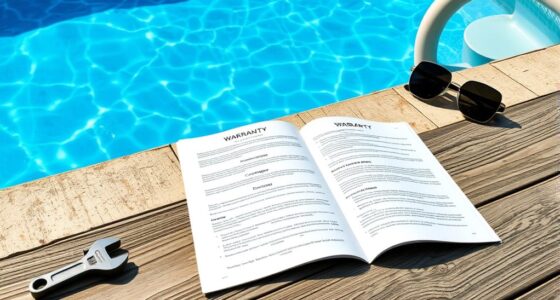To meet legal requirements for pool fencing and barriers, make certain your fence is at least four feet high and made of non-climbable materials. Gates should be self-closing, self-latching, and out of children’s reach to prevent unsupervised access. Regularly inspect and maintain your fence to stay compliant and keep your loved ones safe. Understanding specific laws in your area is essential, so continue exploring to get detailed guidance tailored for you.
Key Takeaways
- Fences must be at least four feet high and constructed from non-climbable materials.
- Gates should be self-closing, self-latching, and out of children’s reach.
- Fencing should have no gaps or weak points that allow climbing or passage.
- Regular inspections are necessary to ensure gates latch properly and fences remain sturdy.
- Compliance with local regulations is mandatory to prevent legal liabilities and ensure safety.

Are you aware of the legal requirements for pool fencing and barriers in your area? If you own a pool, understanding these regulations isn’t just about compliance; it’s about *guaranteeing* child safety and protecting yourself from potential liability. Pool fencing laws are designed to prevent accidents, especially involving young children who might wander into the water unsupervised. These laws typically specify height, gate security, and material standards that fences must meet. For example, many jurisdictions require fences to be at least four feet high, with self-closing, self-latching gates that are out of reach of children. Such measures act as a physical barrier, reducing the risk of accidental drowning.
Understanding local pool fencing laws is essential for child safety and legal compliance.
Child safety should be your top priority. Pool fencing isn’t just a legal obligation—it’s a *fundamental* safety feature. Proper fencing keeps children from accessing the pool area without supervision, giving you peace of mind. It’s *imperative* to choose a fence that’s difficult for kids to climb and to install it correctly, *making certain* there are no gaps or weak points. Many laws also specify the types of materials allowed, often favoring non-climbable surfaces to prevent children from scaling the barriers. Installing compliant fencing demonstrates your commitment to child safety and shows you’re proactive in accident prevention.
Liability insurance is another *essential* reason to adhere to pool fencing laws. If an accident occurs and your pool isn’t properly fenced, you could face legal claims that might not be covered by your insurance. Failing to meet legal fencing requirements can be seen as negligence, which could jeopardize your liability insurance coverage. Many insurers require proof of compliance with local safety standards; otherwise, your policy may be void or limit your coverage in the event of a claim. By installing the appropriate fencing and barriers, you reduce your exposure to costly legal actions and insurance disputes. You also demonstrate responsible ownership, which can positively influence your insurance premiums and coverage options.
In addition to legal and safety considerations, maintaining your pool fencing in good condition is *imperative*. Regular inspections ensure that gates latch properly, fences remain sturdy, and no sections are compromised. This ongoing diligence supports child safety and keeps your liability insurance intact. Remember, laws vary by location, so it’s *important* to consult your local regulations and codes. Staying informed helps you avoid penalties and ensures your pool setup is both safe and compliant. Proper fencing is also supported by essential safety standards, which emphasize the importance of correct installation and maintenance. Ultimately, prioritizing child safety through proper fencing not only fulfills legal obligations but also provides peace of mind, knowing you’ve taken the necessary steps to protect your loved ones and your financial interests.
Frequently Asked Questions
Are Temporary Pool Fences Legally Permitted?
Yes, temporary fencing is legally permitted for pool safety, but it must meet specific safety standards and regulations. You should verify your temporary pool fence is secure, high enough to prevent children from climbing over, and has no gaps or openings that could pose risks. Always check local laws before installation, as requirements can vary. Proper temporary fencing provides effective safety measures until a permanent barrier can be installed.
What Are the Height Requirements for Pool Barriers?
Think of your pool barrier as a fortress wall—standing tall and strong. You should guarantee your pool fencing regulations specify a minimum height of at least 4 feet (1.2 meters) to keep kids out. Many pool designs incorporate these height standards to meet safety codes. By adhering to these fencing regulations, you create a secure environment that keeps hazards at bay, giving you peace of mind every time you enjoy your backyard oasis.
Can I Install a Gate Lock to Meet Legal Standards?
Yes, you can install a gate lock to meet legal standards for pool safety. Focus on pool gate security by choosing a lock that complies with local safety regulations, ensuring it is tamper-proof and self-latching. Proper lock compliance is essential to prevent unauthorized access, especially for children. Regularly check and maintain the lock to keep your pool area secure and compliant with safety laws.
Are There Specific Materials Approved for Pool Fencing?
You should choose pool fencing materials that meet material standards for safety and durability. Approved options include steel, aluminum, and certain types of durable wood or vinyl, which guarantee fence durability and withstand weather conditions. Avoid flimsy or non-compliant materials, as they won’t meet legal standards. Selecting the right, approved materials helps you build a secure, long-lasting barrier that keeps children safe and complies with local regulations.
How Often Must Pool Fences Be Inspected or Maintained?
You should inspect and maintain your pool fence regularly, ideally every three to six months, to guarantee safety. Focus on your pool fence design and fencing material standards, checking for loose or damaged sections, rust, or corrosion. Keep the fencing secure and in good condition, replacing any compromised parts promptly. Proper maintenance helps prevent accidents and ensures your fence continues to meet safety regulations and standards.
Conclusion
So, now that you’re practically a fencing expert, remember: ignoring these laws might not turn your backyard into a secret swimming hole, but it could make you the star of the next headline. Keep those barriers sturdy and compliant, or risk turning your pool party into a costly game of “what not to do.” After all, who wouldn’t want their neighbors to have a front-row seat to a poolside safety lecture? Stay safe, stay legal—and maybe, just maybe, stay dry.









